This Sardine curry is a classic coastal fish curry made with fresh or canned sardines cooked in tangy and spicy coconut-based curry in just 30 minutes. This Indian fish curry is from Mangalorean cuisine perfect for a quick lunch/dinner. Serve this Tarle curry/bhuthai meen ghassi with hot steamed rice. Here’s how to make it with step-by-step photos and a quick video tutorial.
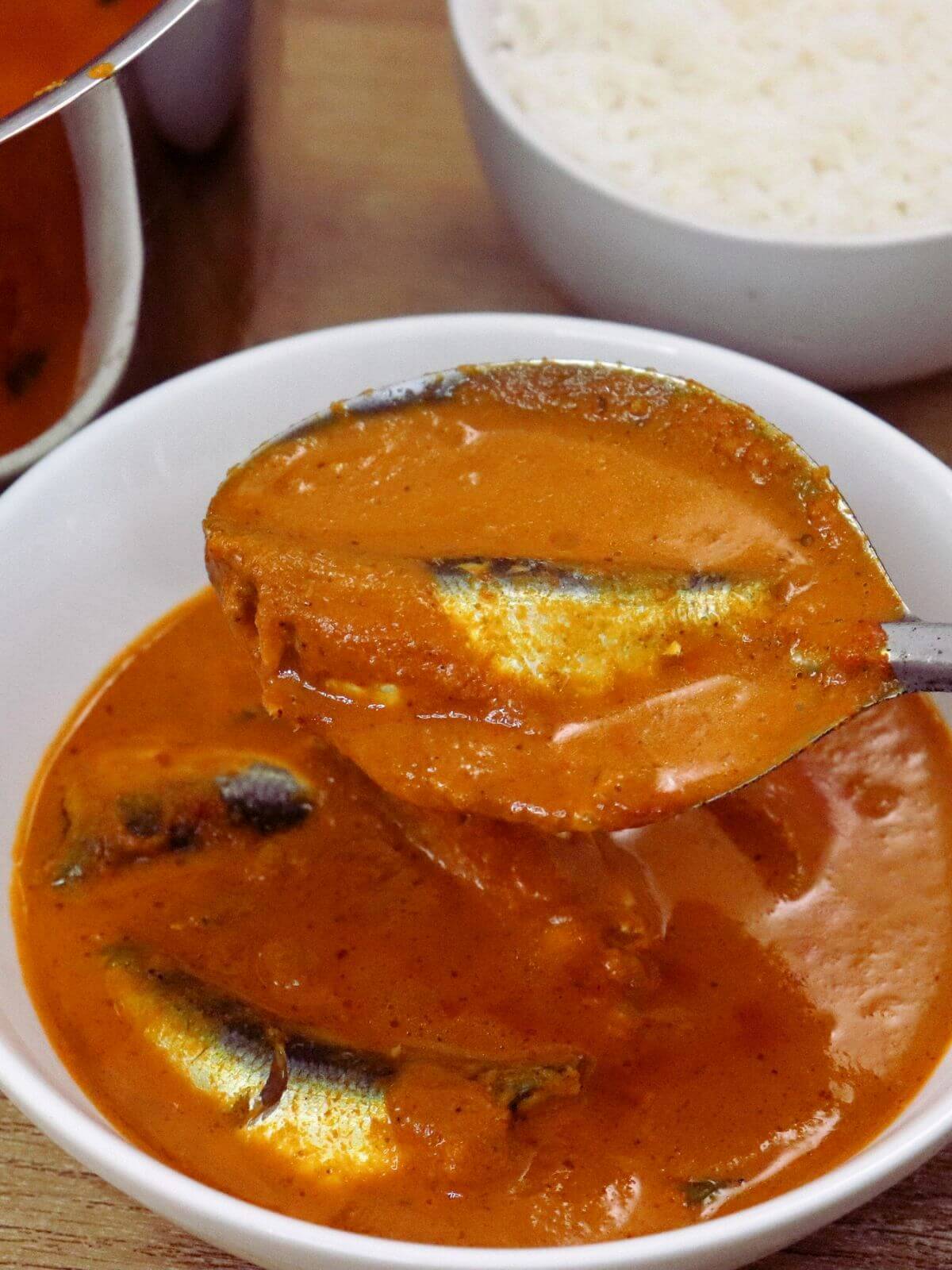
Jump to:
I enjoyed this Sardine curry first time in Mangalore at my in-laws' place. The tangy, spicy flavors combined with the unique aroma of Sardine were delightful. The sardines were perfectly tender and juicy, and the bold, fiery Mangalorean spices made every bite incredible.
This sardine curry recipe is for all those who love spicy and tangy fish curry. Sardines are a cost-effective and nutritious option. They are packed with essential vitamins and omega-3 fatty acids, making this sardine fish curry both nutritious and economical. Similar fish recipes that are super easy to make and taste wonderful are Bangude Ghassi, Goan Fish Curry, Stuffed Mackerel, Bangude Pulimunchi, or Mackerel Fry.
About This Sardine Curry
In this recipe post, I am sharing how to make Sardine curry. This is a traditional recipe and how we make it at home. Fresh or canned sardines both work well for this recipe. It is a basic fish curry recipe that can be made with any other fish like Mackerel, King fish, or Pomfret.
Mangalorean-style Sardine fish curry is locally called 'Buthai Meen Ghassi' or 'Tarle Curry' in the local language of Mangalore, India. The word “Buthai Meen” is the local name for Sardine fish and “Ghassi” means curry.
The recipe for Bhutai Meen Ghassi/Tarle curry is simple. First, prepare the flavorful coconut masala paste, bring it to a boil, and gently add the sardines. Cook for a couple of minutes, and your spicy and tangy Bhutai Meen Ghassi/Tarle curry is ready to serve.
You may also like these other popular Indian fish recipes from this website:
- Mangalorean Mackerel Curry
- Goan Fish Curry
- Mangalorean Fish Masala Fry
- Fish Rava Fry
- Andhra Fish Fry
- Mackerel Fish Fry
Ingredients Notes
This sardine curry is a staple in Mangalorean households. Known for its perfect blend of tangy tamarind, fiery byadagi red chili, aromatic spices, and creamy coconut, this coastal Karnataka fish curry brings out the bold flavors of Sardines. Here's what you will need to make this recipe.
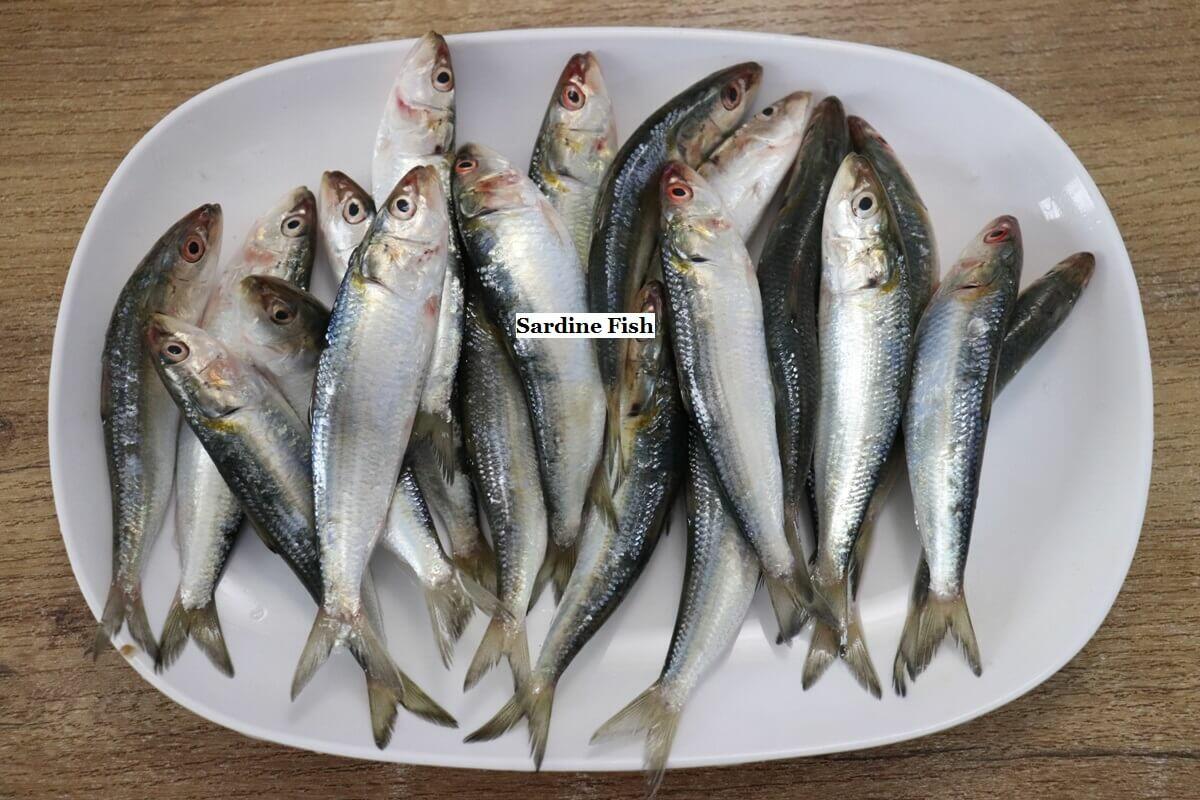
- Sardine fish (Buthai Meen or Tarle): I reside in a coastal region of India, Goa, where fresh Sardines are abundantly available year-round, except on rainy days. I used fresh Sardine also known as "Buthai Meen or Tarle". Canned sardines in olive oil or frozen sardines also work well for this fish curry recipe. This versatile recipe can be made with any fish like Mackerel (bangda), Kingfish (Iswan), Salmon (Rawas), or False trevally/white Fish (Saundale). I have given a few tips for choosing fresh Sardines in the FAQ section.
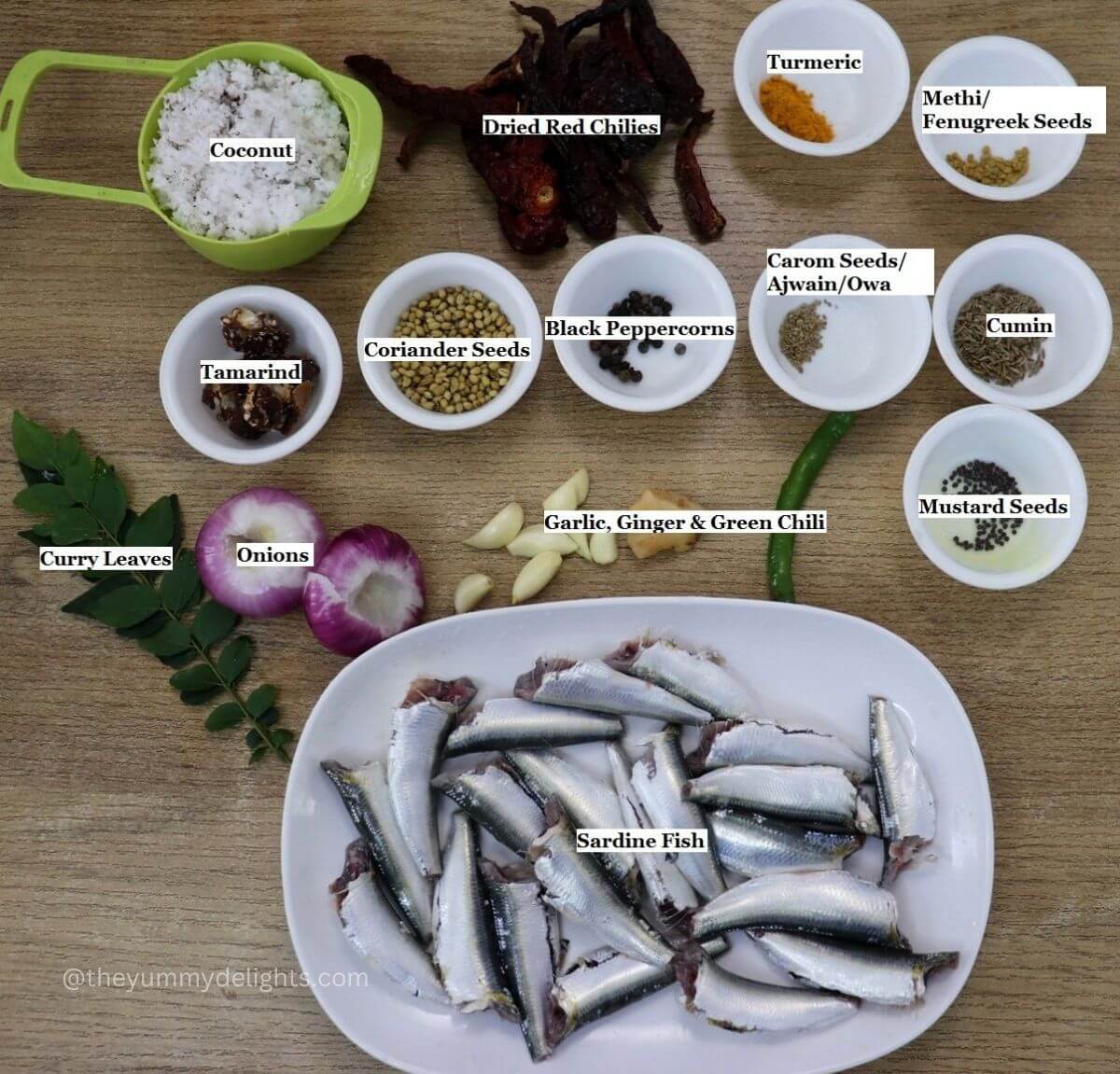
- Byadagi Red Chilies: I used Byadagi red chilies that give a bright color to this Sardine curry recipe and these chilies are less spicy. You can substitute them with Kashmiri red chilies or any dried red chilies but add them as per taste. You can deseed the red chilies to reduce the spiciness.
- Spices: I used coriander seeds, cumin, fenugreek seeds/methi dana, mustard seeds/rai, and black peppercorns. You can skip mustard seeds but do not skip any other ingredient, as it may alter the taste of this Mangalorean fish curry.
- Coconut: I used scraped fresh coconut for this Tarle curry recipe. You can substitute it with coconut milk.
- Tamarind: Add a tangy taste and authentic Mangalorean flavor to the fish curry. Substitute it with lemon/lime juice.
- Onion, Ginger, and Green Chili: I used red onion for this fish curry. You can substitute it with white onions or shallots. You can skip green chilies if you do not prefer spicy fish curry.
- Curry Leaves: a must for that authentic South Indian flavor and aroma of traditional Mangalorean fish curry.
For the detailed list of ingredients & their measurements, please check out the recipe card below. Here's how to make sardine curry.
How to make Sardine curry
1) Remove the scales, head, and guts of the sardines. Rinse them well under cold water and pat them dry with paper towels. If using canned sardines open the can.
Making the sardine curry masala
2) In a heavy bottom pan, dry roast 10 dried red chilies, stirring continuously until aromatic and crisp on medium-low heat. Transfer to a mixer jar.
3) In the same pan, add coriander seeds, cumin, fenugreek seeds/methi, mustard seeds/rai, and black peppercorns. Dry roast until aromatic on low heat, stirring continuously. Add to the mixer jar.

4) To the mixer jar, add coconut, onion, garlic cloves, turmeric, and tamarind. Add a little water and grind to a fine paste. Keep this fish curry masala aside.
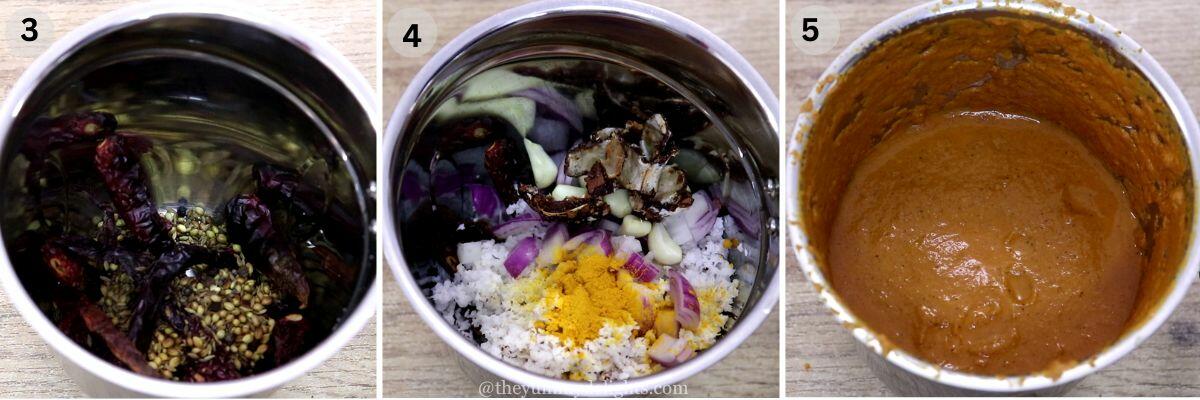
Making the Sardine curry
5) Heat 2 teaspoon oil in a heavy bottom pan over medium heat. Saute onion, curry leaves, ginger, and green chili until onions are translucent.
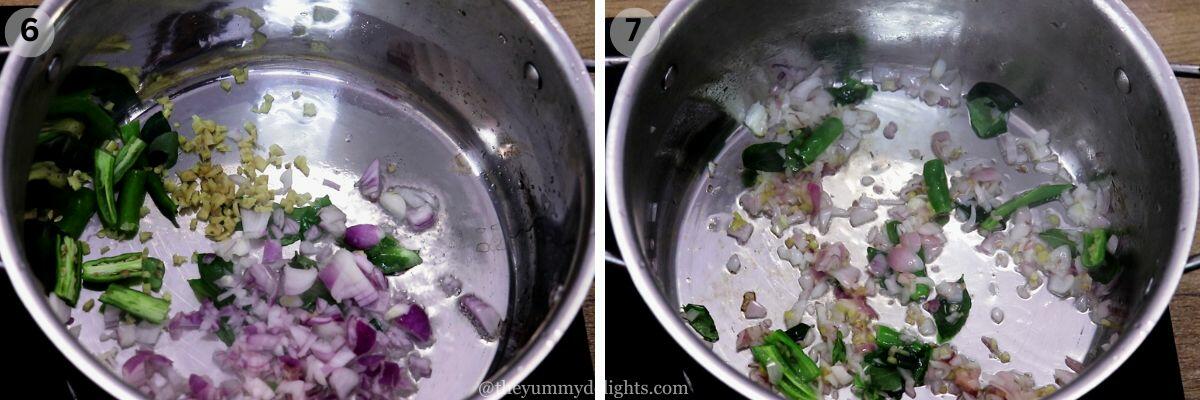
6) Add the fish curry masala paste. Add water to adjust the consistency of the fish curry. Add salt to taste. Let it come to a boil.
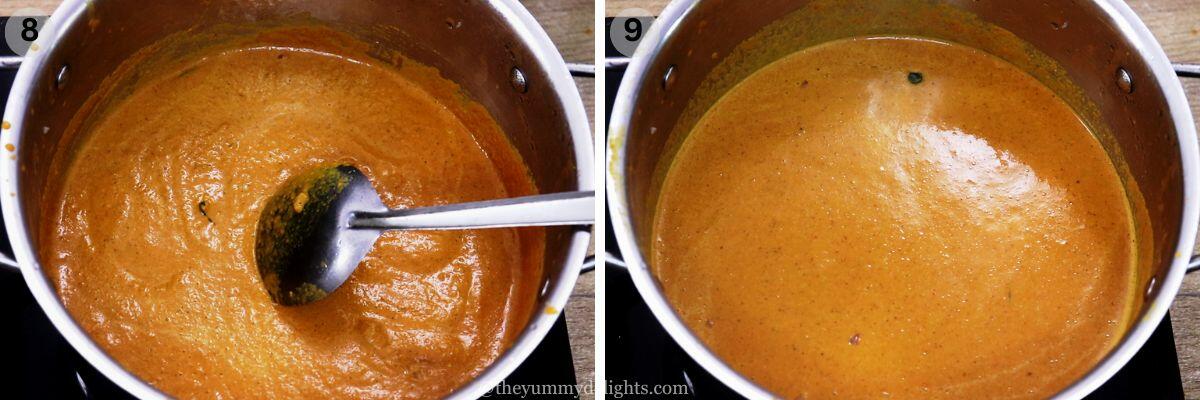
7) Add sardine fish.
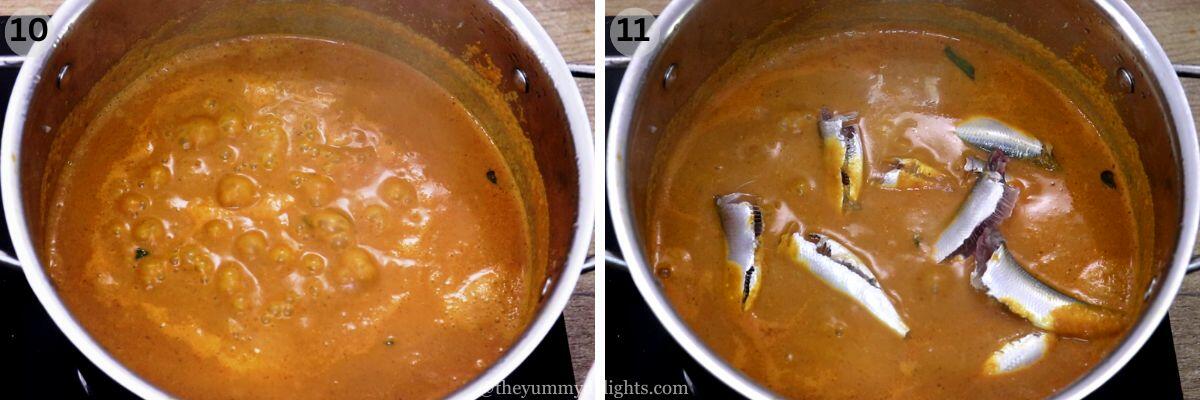
8) Instead of stirring the fish curry with a ladle, simply hold the pot by its handles and gently swirl the contents in a circular motion. Do not use a ladle or spoon to stir sardine fish curry. You can see the process in the video. Cook sardines for 2-3 minutes, and then remove from heat. Sardine curry is ready to serve. Enjoy it with steamed rice.
Tip: Avoid overcooking, as the fish can disintegrate in the curry.
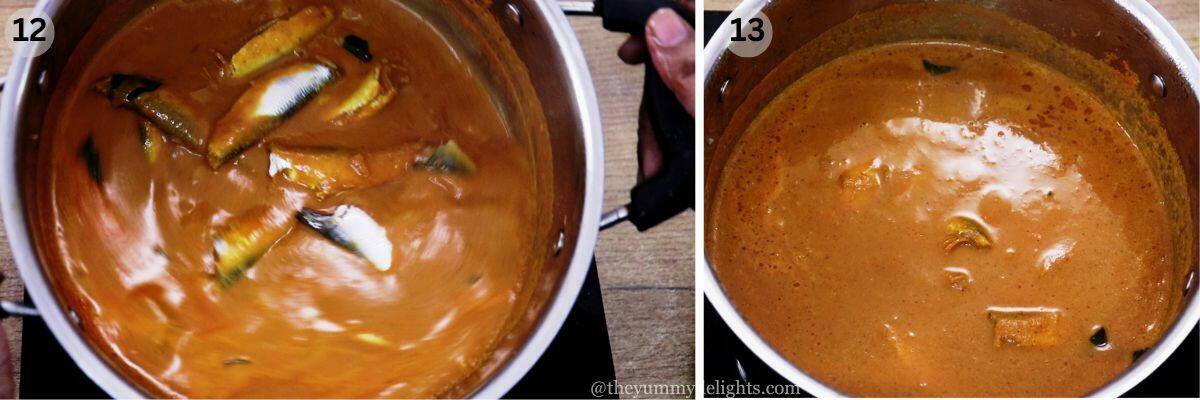
Tips to make the Best Sardine Curry
- Follow the measurements of the ingredients properly. Too much of any ingredient can ruin the fish curry.
- To prevent overcooking and disintegration, cook the fish just until it flakes easily with a fork. Overcooking can lead to dry, flaky fish. The cooking time depends on the thickness of the fillets and curry heat, but fish cooks quickly.
- If you do not have tamarind then substitute with lemon or vinegar. Or, if you have Kokum, add the kokum to the fish curry while adding green chilies.
- Instead of stirring the sardine in fish curry with a ladle, hold the pot by its handles and gently swirl the contents in a circular motion. The ingredients are mixed evenly by rotating the pot without breaking apart the fish pieces or disturbing the delicate flavors. This technique helps maintain the dish's integrity and ensures a smooth, well-blended curry.
Frequently Asked Questions
To buy fresh sardines, look for fish with clear, shiny eyes, bright red or pink gills, and a clean, slightly briny smell. The flesh should be firm and spring back when pressed and the skin should be shiny and smooth. Avoid fish with dull eyes, dark gills, a strong fishy odor, or a dry, scaly appearance.
1) Choose your Sardines: If fresh fish isn’t available, canned sardines make a great alternative. You can use canned sardines in olive oil if you are following this recipe.
2) Drain or use oil: If the canned sardines are in olive oil, you can use this oil to sauté your onions and spices. Drain if you prefer a less oily curry.
3) Add fish towards the end of cooking: Canned sardines are pre-cooked, so they should be added near the end of cooking to keep their texture intact.
4) Stir them gently: Canned sardines can break apart easily. Stir them gently to avoid breaking them apart too much.
Sardines cook quickly, so only cook them for a few minutes or until they are just cooked through. Overcooking can make them dry and disintegrate in the curry.
This fish curry is traditionally served with steamed rice or appam. You can also serve it with Neer dosa.
If you try this recipe, please leave a comment and rating below. We'd love to hear your feedback.
For any questions or concerns while making this recipe, please get in touch with me directly at nayakprety@gmail.com. I'll try my best to respond promptly.
And, consider following me on social media so we can stay connected. I’m on Facebook, Pinterest, and YouTube!
Recipe Card
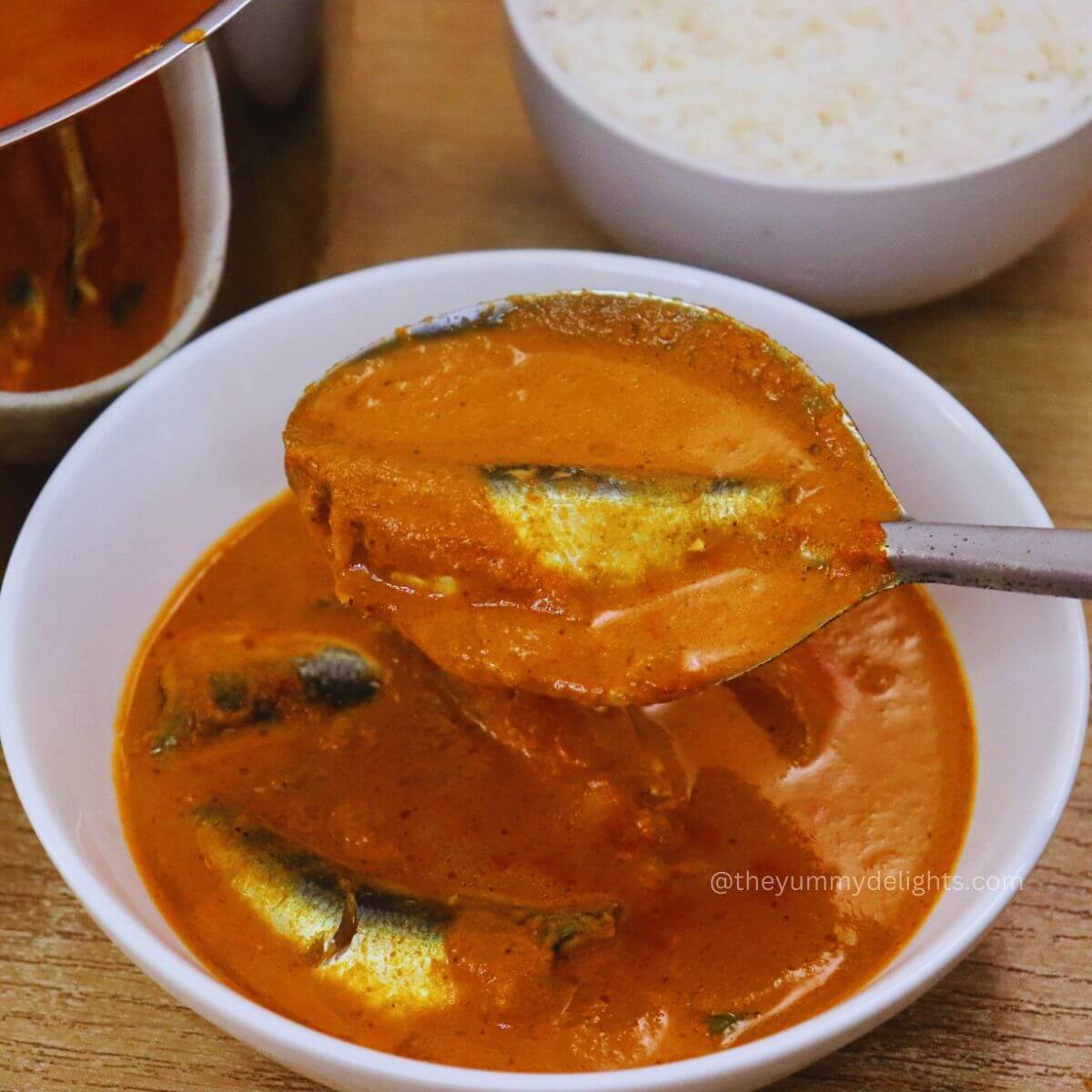
Sardine Curry (Buthai Meen Ghassi/Tarle Curry)
Video

Equipment
- 1 Heavy bottom pan
- 1 Heavy bottom pot
Ingredients
- 500 gram Sardine (fresh or canned) Also known as Buthai Meen/Tarle.
For the fish curry masala
- 10 dried red chilies Byadagi/Kashmiri
- 4 teaspoon coriander seeds
- 1 teaspoon cumin/jeera
- ¼ teaspoon fenugreek seeds/methi
- ¼ teaspoon mustard seeds/rai
- ½ teaspoon black peppercorn
- 1 cup grated/scraped coconut
- 1 onion chopped
- 7 garlic cloves
- ¼ teaspoon turmeric
- 1 small lemon size tamarind
For the curry
- 1 small onion chopped
- 2 sprig curry leaves
- 1- inch ginger chopped
- 1 green chili slit
- salt
Instructions
- Remove the scales, head, and guts of the sardines. Rinse them well under cold water and pat them dry with paper towels. If using canned sardines open the can.
Making the sardine curry masala
- In a heavy bottom pan, dry roast 10 dried red chilies, stirring continuously until aromatic and crisp on medium low heat. Transfer to a mixer jar.
- In the same pan, add coriander seeds, cumin, fenugreek seeds/methi, mustard seeds/rai, and black peppercorns. Dry roast until aromatic on low heat, stirring continuously. Add to the mixer jar.
- To the mixer jar, add coconut, onion, garlic cloves, turmeric, and tamarind. Add little water and grind to a fine paste. Keep this coconut masala aside.
Making the Sardine fish curry
- Heat 2 teaspoon oil in a heavy bottom pan over medium heat.
- Saute onion, curry leaves, ginger, and green chili until onions are translucent.
- Add the masala paste. Add water to adjust the consistency of the fish curry. Add salt to taste. Let it come to a boil.
- Add the cleaned sardine. Instead of stirring the fish curry with a ladle, simply hold the pot by its handles and gently swirl the contents in a circular motion. Do not use ladle or spoon to stir this sardine fish curry. Cook for 2-3 minutes, or until fish is just cooked and then remove from heat. Serve this sardine curry with steamed rice.
Notes
- Follow the measurements of the ingredients properly. Too much of any ingredient can ruin this sardine curry.
- Traditionally, a pinch of carom seeds (ajwain/owa) is added to the Mangalorean fish curry. I have made this sardine curry with carom seeds and without it. There is not much difference. So I have skipped the addition of carom seeds for this recipe. We make this Mangalorean fish curry every time at home without carom seeds.
- To prevent overcooking and disintegration, cook the fish just until it flakes easily with a fork. Overcooking can lead to dry, flaky sardine fish. The cooking time depends on the thickness of the fillets and curry heat, but fish cooks quickly.
- If you do not have tamarind then substitute with lemon or vinegar. Or, if you have Kokum, add the kokum to the fish curry while adding green chilies.
- Instead of stirring the fish curry with a ladle, simply hold the pot by its handles and gently swirl the contents in a circular motion. By rotating the pot, the ingredients are mixed evenly without breaking apart the fish pieces or disturbing the delicate flavors. This technique helps to maintain the integrity of the dish and ensures a smooth, well-blended curry.
Nutrition
Nutrition information is automatically calculated, so should only be used as an approximation.

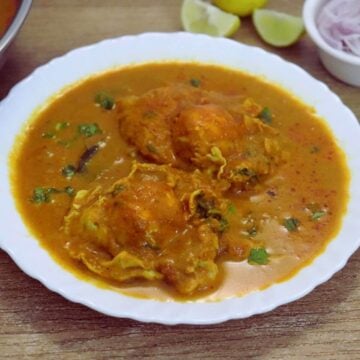



Shanaya
I just tried this Manglorean Sardine Curry, so flavorful, just like my mom make it at home. Thanks for sharing.
Preeti
Glad you liked it. Thanks for trying the recipe.